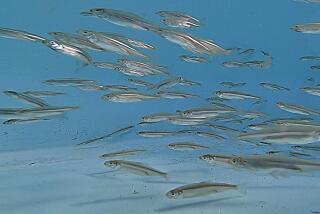Still Angling for an End to This Fish Story
- Share via
PORTOLA, Calif. — There are no bad ideas here.
Nothing too outrageous, too expensive or too implausible to merit consideration by state wildlife officials desperate to rid Lake Davis of the saw-toothed scourge of the Sierra.
From science to science fiction, every possibility that swims by gets serious attention here these days in the frantic effort to eradicate the rapacious northern pike.
“Help us with an idea,” Leonard Marsh, chairman of the Save Lake Davis Coalition, implored at a community meeting Thursday night. “You may think it’s a harebrained idea. But even harebrained ideas can work. Look at Ben Franklin with the key and the kite and the lightning storm.”
The razor-toothed predator mysteriously returned to Lake Davis in late May, 19 months after the state poisoned the lake against residents’ wishes to save the fragile salmon population downstream from the pike’s voracious appetite. The process cost the state more than $14 million and destroyed a major part of this town’s water supply.
Already under consideration to help contain the pike are proposals to:
* Put in really big trout to eat the really little pike, in a kind of reverse predator-prey relationship.
* Install underwater electric fences to zap the pike should they dare stray south, en route to the Sacramento-San Joaquin Delta and the threatened salmon and steelhead trout populations 130 miles away.
* Bring down the lake’s water level during spawning season to dry out pike eggs before they hatch.
* Detonate underwater explosives and hope the concussions turn predator into puree.
* Stun the fish with special electroshock boats, then scoop them up and kill them.
* Fish a lot.
* Give up and let the pike take over this formerly pristine trout fishery 50 miles northwest of Reno.
The only thing that’s at all doubtful is another round of chemical treatment like the one that temporarily killed all aquatic life in the alpine lake and put a big crimp in the local economy, which is heavily dependent on outdoor tourism.
In Search of a Silver Bullet
And even that is not entirely out of the question. Plumas County Supervisor Fran Roudebush wanted to fire off a letter to Gov. Gray Davis shortly after the pike reappeared at the end of May, saying something like: “Promise us--in writing--that no chemical whatsoever will ever, ever, ever be dumped in our all-important lake.”
And now? On the off chance that a silver pike bullet is out there in some scientist’s laboratory that could kill the pike, do no harm to humans and leave the rest of the fish population alone, she’s painstakingly drafting a missive to Sacramento asking for a gubernatorial pledge that wildlife officials will dump “no Prop. 65 chemicals, the cancer-causers, or ones with a residual effect” into Lake Davis.
Here in the town with the I-told-you-so eyes, the looks that say more loudly than words “We knew your poison wouldn’t work and we were right,” not everyone was delighted to hear from Robert Hight, new director of the state Department of Fish and Game, when he flew in from Sacramento to meet with townsfolk at Thursday’s meeting.
“I would like to suggest Mr. Hight go back to Sacramento with his CHP Gestapo and never come back to Lake Davis again,” Jack Herzberg of nearby Crocker Mountain said during the meeting, which was attended by white-haired ladies wearing Miss America-type sashes made of wide, blue ribbon reading “Save Lake Davis.”
Doing well here, after having done badly, is crucial for the Fish and Game Department. Says senior fishery biologist Nick Villa: “Every decision we make right now has to be immaculate. . . . We’ve learned the hard way we can’t just roll over the community and do something.”
It is important enough for the department to pledge $1.8 million over the next 18 months and staff a full-time center here to fight the pike.
“I care what they have to say, and I want them to know I’m listening,” Hight said in an interview. “I think we can have people not shut out and we can fix the pike. . . . I’m the first [Fish and Game] director to come here. I didn’t get lynched.”
The fish story began five years ago when, wildlife officials suspect, a rogue angler dumped northern pike into this premier trout lake. Native east of the Mississippi, the pike has been known to eat almost anything that moves: ducks, muskrats, other fish. A fierce fighter, the pike is prized as a game fish.
But this is not its home, and it isn’t welcome. Fearing that the pike would escape the lake, head down the Feather River toward the delta and eventually destroy the salmon population, the Fish and Game Department overrode local wishes and poisoned the lake in October 1997.
Images of the treatment effort, with agents in boats wearing white hazardous materials suits and scores of law enforcement officers keeping the peace, were beamed across the country. The poisoning and its aftermath--including $9.1 million in damage--has cost the state an estimated $14.2 million so far.
The agency has restocked the lake with 3 million trout of varying sizes, including 5,940 “catchables” released Thursday morning. Although the lake has been certified to be free of chemicals, local officials have yet to vote to resume using Lake Davis as a water source.
Pike Experts to Visit Scene
With 40 pike discovered here since late May, local and wildlife officials have contacted pike experts nationwide for advice and assistance. Two will come to Portola this month to check out the pike’s possible path to the delta. They will help figure out a plan for control in the short term and, it is hoped, eradication in the long term.
The Save Lake Davis Coalition’s Marsh has exchanged e-mail with Doug Krieger, a senior aquatic biologist with the Colorado Division of Wildlife, about his state’s battle with the toothy predator. Colorado introduced the pike more than 50 years ago to help control carp and white suckers in the upper South Platte River system near Denver.
It worked for a while, as long as the state fluctuated the water level in a reservoir where most of the pike lived. Changing water levels meant that spawning grounds were uncertain, and the pike could never reproduce rapidly enough to be a problem.
But about 20 years ago, Colorado’s water management practices changed, Krieger said. The state stopped relying on Eleven Mile Reservoir, home of the pike, for water, and the reservoir levels stabilized, allowing regular spawning. In addition, cutbacks have lessened the number of trout the wildlife division is able to stock. Now Colorado is in the same awkward spot as Portola.
“Our choice: Do we have trout fishing or do we have a northern pike fishery?” Krieger said. While Colorado has poisoned bodies of water in the past to manage predators, Krieger said such an action is not an option this time.
“What we’ll try to do in the short term is encourage harvest by anglers,” he said. “Water level fluctuation may be a possibility. It would be extremely difficult to do that without the city of Denver losing water yield. They may be willing to talk to us about it . . . I’m afraid I don’t have a silver bullet for the folks in Lake Davis.”
The California Department of Fish and Game is also working to bring an expert on fish, water and electricity to Portola to determine if a sort of underwater electrical fence could be installed at the points where the lake spills into Grizzly Creek.
Dave Smith is president of Smith-Root Inc. of Vancouver, Wash., a company that has patented such devices and installed them across the country to keep fish out of steel mills, shipping channels, dam turbines and other places where they aren’t welcome.
The company’s electrical barriers generally consist of concrete pads installed across the bottom of waterways. Within the concrete are electrodes that emit pulses of electricity that the fish will not cross.
Smith predicts his fences will stop “95% or more of the fish” from leaving the lake, but some of the smaller ones may get through. A secondary system might be required.
“We work with ways that don’t use poisons and don’t affect water quality,” Smith said. “I don’t know any fish species that likes the feeling of electric shock.”
No one knows whether any pike have already escaped and headed downstream. Wildlife agents here have installed trap nets, strung on orange buoys around Mosquito Slough, the area of Lake Davis where most of the pike have been caught, in an effort to round up others.
In addition, they have fitted the lake’s outflow areas with “graters” to shred fish that escape from the dam. Residents have dubbed them “sushi bars.”
Villa figures that in the short term a combination of efforts will have to be employed, because no one measure will be enough.
Multiple strategies, Villa says, “could have a cumulative effect to hold down the size of the population. I don’t think any of these could eradicate the pike. [But] we’ll take anything we can get at this point. We’re desperate.”
More to Read
Sign up for Essential California
The most important California stories and recommendations in your inbox every morning.
You may occasionally receive promotional content from the Los Angeles Times.











